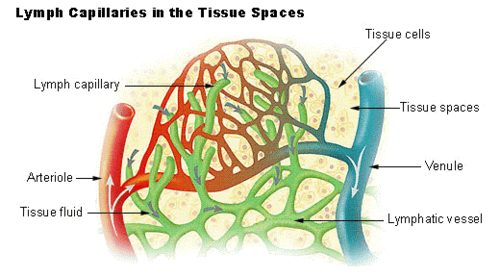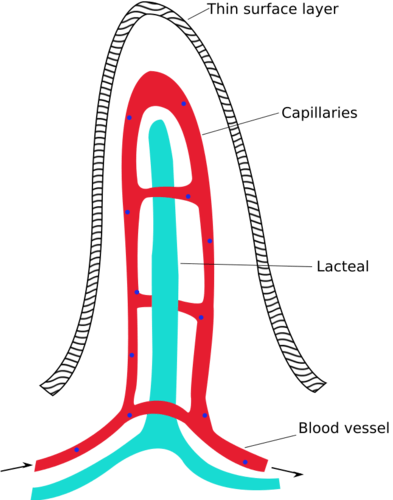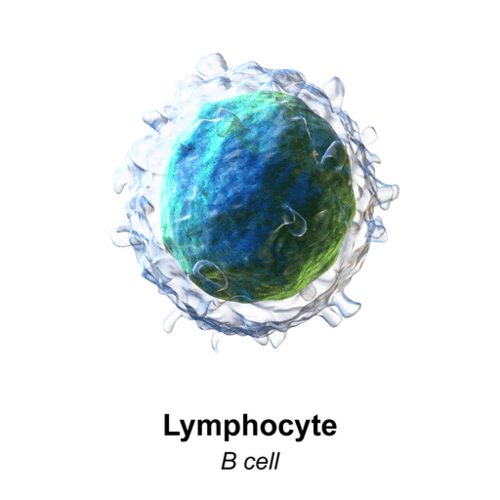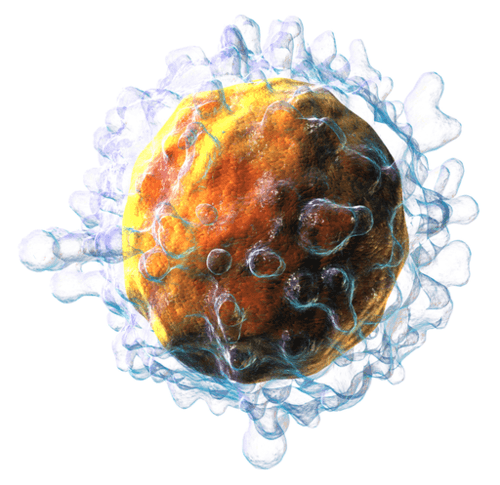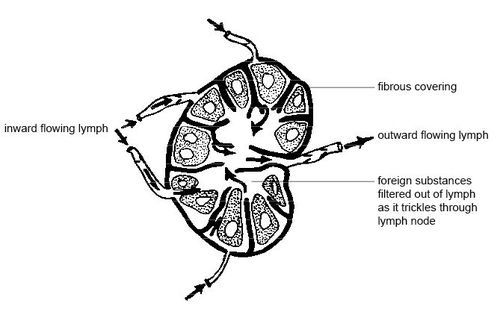19.3 淋巴系统
章节大纲
-
Tonsillitis
::吨数The white patches on either side of the throat in this picture are signs of tonsillitis. The tonsils are small structures in the throat that are very common sites of infection. The white spots on the tonsils pictured here are evidence of infection. The patches consist of large amounts of dead , cellular debris, and white blood cells — in a word: pus. Children with recurrent tonsillitis may have their tonsils removed surgically to eliminate this type of infection. The tonsils are organs of the lymphatic system.
::在这张图片中,喉咙两侧的白斑点都是扁桃腺的症状,扁桃腺是喉部的小型结构,是非常常见的感染地点,这里所描绘的扁桃腺上的白斑点是感染的证据,包括大量死亡、细胞残块和白血细胞——简而言之:pus。患有复发性扁桃腺的儿童可能通过手术将扁桃腺切除,以消除这种感染,扁桃体是淋巴系统器官。What Is the Lymphatic System?
::什么是淋巴系统?The lymphatic system is a collection of organs involved in the production, maturation, and harboring of white blood cells called lymphocytes . It also includes a network of vessels that transport or filter the fluid known as lymph in which lymphocytes circulate. The figure shows major lymphatic vessels and other structures that make up the lymphatic system. Besides the tonsils, organs of the lymphatic system include the thymus , the spleen , and hundreds of lymph nodes distributed along the lymphatic vessels.
::淋巴系统是参与生产、成熟和保存称为淋巴细胞的白细胞的器官的集合体,还包括一个运输或过滤淋巴细胞循环的淋巴液的船只网络,图中显示了构成淋巴细胞系统的主要淋巴血管和其他结构,除子外,淋巴系统的器官包括胸腺、脾脏和沿淋巴细胞血管分布的数百个淋巴结。The lymphatic system includes organs such as the thymus and spleen, as well as a body-wide network of vessels that transport lymph.
::淋巴系统包括胸腺和脾脏等器官,以及一个运输淋巴的全体船只网络。The lymphatic vessels form a transportation network similar in many respects to the of the . However, unlike the cardiovascular system, the lymphatic system is not a closed system. Instead, lymphatic vessels carry lymph in a single direction — always toward the upper chest, where the lymph empties from lymphatic vessels into blood vessels.
::淋巴类船只构成一个交通网络,在许多方面与人体系统相似,但与心血管系统不同,淋巴类系统不是一个封闭系统,而淋巴类船只只向一个方向携带淋巴,总是向上胸部,从淋巴类船只进入血管的淋巴管。Cardiovascular Function of the Lymphatic System
::淋巴系统心血管功能The return of lymph to the bloodstream is one of the major functions of the lymphatic system. When travels through capillaries of the cardiovascular system, it is under pressure, which forces some of the components of blood (such as , oxygen, and nutrients) through the walls of the capillaries and into the tissue spaces between , forming tissue fluid, also called interstitial fluid (see figure ). Interstitial fluid bathes and nourishes cells, and also absorbs their waste products. Much of the water from interstitial fluid is reabsorbed into the capillary blood by . Most of the remaining fluid is absorbed by tiny lymphatic vessels called lymph capillaries. Once interstitial fluid enters the lymphatic vessels, it is called lymph. Lymph is very similar in composition to blood plasma. Besides water, lymph may contain , waste products, cellular debris, and . It also contains numerous white blood cells, especially the subset of white blood cells known as lymphocytes. In fact, lymphocytes are the main cellular components of lymph.
::淋巴细胞返回血液流是淋巴系统的主要功能之一。当淋巴系统穿透心血管系统毛细带时,它处于压力之下,迫使血液的某些成分(如氧和营养素)通过毛细管的墙壁,进入淋巴血管之间的组织空间,形成组织液,也称为淋巴液(见图) 淋巴液和营养细胞,并吸收它们的废物。间流水中的很多水被重新吸收到毛细管血液中。残留的液体大部分被叫做淋巴卡的微小淋巴血管吸收。一旦淋巴液进入淋巴血管,它就被称为淋巴。淋巴在血浆的构成方面非常相似。除了水、淋巴可能含有废物、细胞残渣和。它还包括许多白血细胞,特别是被称为淋巴细胞的白色血细胞子。事实上,淋巴细胞是主要的细胞组成。Fluid and other substances in blood are forced by blood pressure through the walls of capillaries and into the surrounding tissue spaces. Some of the tissue fluid is absorbed by tiny lymphatic vessels, forming lymph. The arrows show the direction of blood and lymph through the blood and lymphatic vessels.
::血液中的流体和其他物质因血压而被迫穿透血管壁,进入周围的组织空间,有些组织液被微小的淋巴血管吸收,形成淋巴,箭头通过血液和淋巴血管显示血液和淋巴的方向。The lymph that enters lymph capillaries in tissues is transported through the lymphatic vessel network to two large lymphatic ducts in the upper chest. From there, the lymph flows into two major veins (called subclavian veins) of the cardiovascular system. Unlike blood, lymph is not pumped through its network of vessels. Instead, lymph moves through lymphatic vessels via a combination of contractions of the vessels themselves and the forces applied to the vessels externally by . Lymphatic vessels also contain numerous valves that keep lymph flowing in just one direction, thereby preventing backflow.
::通过淋巴容器网络将进入组织中的淋巴结膜的淋巴风吹到上胸的两根大淋巴管上,从那里,淋巴风流进入心血管系统的两大血管(称为亚硅血管),与血液不同的是,淋巴风没有通过血管网络抽取,而淋巴淋巴通过淋巴船通过船只本身的收缩和对外部船只施压相结合的方式移动。 淋巴气轮也含有许多阀门,使淋巴风仅向一个方向流动,从而防止回流。Digestive Function of the Lymphatic System
::淋巴系统消化功能Lymphatic vessels called lacteals (see figure ) are present in the lining of the gastrointestinal tract , mainly in the . Each tiny villus in the lining of the small intestine has an internal bed of capillaries and lacteals. The capillaries absorb most nutrients from the digestion of food into the blood. The lacteals absorb mainly fatty acids from digestion into the lymph, forming a fatty-acid-enriched fluid called chyle. Vessels of the lymphatic network then transport chyle from the small intestine to the main lymphatic ducts in the chest, from which it drains into the blood circulation. The nutrients in chyle then circulate in the blood to the liver , where they are processed along with the other nutrients that reach the liver directly via the bloodstream.
::被称为 lacteal (见图) 的液态血管存在于胃肠道的衬里,主要是在肠道的衬里。小肠衬里的每一小贝壳都有一个内脏的毛细和衬垫床。 毛细胞吸收了食物消化到血液中的大部分养分。 脂类主要吸收了从消化到淋巴中的脂肪酸,形成一种脂肪酸化液,即酸液。 淋巴网络的螺丝,然后将从小肠到胸部的主要淋巴管,从中排入血液循环中。 毛细胞的养分随后在血液中循环到肝脏中, 与直接通过血液到达肝脏的其他养分一起处理。Vessels called lacteals in the villi lining the small intestine are the main way that fatty acids from digestion are absorbed from the gastrointestinal tract. These nutrients eventually reach the blood circulation after traveling through the network of lymphatic vessels.
::小肠内衬中称为液化盐的船舶是消化液中的脂肪酸从胃肠道吸收的主要途径,这些养分在通过淋巴血管网络旅行后最终会达到血液循环。Immune Function of the Lymphatic System
::Lympphycial System的免疫功能The primary immune function of the lymphatic system is to protect the body against pathogens and cancerous cells. This function of the lymphatic system is centered on the production, maturation, and circulation of lymphocytes. Lymphocytes are leukocytes that are involved in the adaptive immune system . They are responsible for the recognition of — and tailored defense against — specific pathogens or tumor cells. Lymphocytes may also create a lasting memory of pathogens, so they can be attacked quickly and strongly if they ever invade the body again. In this way, lymphocytes bring about long-lasting to specific pathogens.
::淋巴细胞系统的主要免疫功能是保护身体不受病原体和癌症细胞的伤害,淋巴细胞系统的这一功能以淋巴细胞的生产、成熟和循环为中心,淋巴细胞是参与适应性免疫系统的白细胞,它们负责确认特定病原体或肿瘤细胞,并有针对性地加以防守,淋巴细胞还可能造成对病原体的持久记忆,因此如果它们再次侵入人体,它们可以受到迅速和强烈的打击,这样,淋巴细胞就会导致特定病原体长期存在。There are two major types of lymphocytes, called B cells and T cells , which are illustrated in the figure. Both B cells and T cells are involved in the adaptive immune response , but they play different roles. You can learn more about their immune functions by reading the concept Adaptive Immune System.
::淋巴细胞有两大类,称为B细胞和T细胞,图中说明了这两类情况。B细胞和T细胞都参与了适应性免疫反应,但它们的作用不同。通过阅读适应性免疫系统的概念,你可以更多地了解它们的免疫功能。Production and Maturation of Lymphocytes
::伦皮细胞的生产和成熟Like all other types of blood cells (including red blood cells), both B cells and T cells are produced from cells in the red marrow inside . After lymphocytes first form, they must go through a complicated maturation process before they are ready to search for pathogens. In this maturation process, they “learn” to distinguish self from non-self. Only those lymphocytes that successfully complete this maturation process go on to actually fight infections by pathogens.
::与所有其他类型的血细胞(包括红血细胞)一样,B细胞和T细胞都是由红骨中的细胞生成的。在淋巴细胞以第一种形式出现后,它们必须经历复杂的成熟过程,然后才准备寻找病原体。在这一成熟过程中,它们“脱胎”以区分自我和非自身。只有成功完成这一成熟过程的淋巴细胞才能真正与病原体感染作斗争。B cells mature in the bone marrow , which is why they are called B cells. After they mature and leave the bone marrow, they travel first to the and then enter the lymphatic system to search for pathogens. T cells, on the other hand, mature in the thymus, which is why they are called T cells. The thymus is illustrated in the figure . It is a small lymphatic organ in the chest that consists of an outer cortex and inner medulla, all surrounded by a fibrous capsule . After maturing in the thymus, T cells enter the rest of the lymphatic system to join B cells in the hunt for pathogens. The bone marrow and thymus are called primary lymphoid organs because of their role in the production and/or maturation of lymphocytes.
::在骨髓中成熟的B细胞,这就是为什么它们被称为B细胞的原因。在它们成熟后离开骨髓后,它们先到淋巴系统,然后进入淋巴系统以寻找病原体。另一方面,细胞在胸腺中成熟,这就是为什么它们被称为T细胞。胸腺在图中图解。胸腔中是一个小淋巴器官,由外皮层和内膜组成,周围都是纤维囊。在胸腔中成熟后,细胞进入淋巴系统的其他部分,加入B细胞以寻找病原体。骨髓和胸腺被称为淋巴,因为它们在淋巴细胞的生产和(或)发酵中发挥作用。The thymus is an important organ of the lymphatic system because it is the location of T cell maturation.
::胸腺是淋巴系统的一个重要器官,因为它是T细胞成熟的地点。Lymphocytes in Secondary Lymphoid Organs
::二级淋巴器官中的淋巴细胞The tonsils, spleen, and lymph nodes are referred to as secondary lymphoid organs. These organs do not produce or mature lymphocytes. Instead, they filter lymph and store lymphocytes. It is in these secondary lymphoid organs that pathogens (or their antigens) activate lymphocytes and initiate adaptive immune responses. Activation leads to of pathogen-specific lymphocytes, which then circulate between the lymphatic system and the blood, searching for and destroying their specific pathogens by producing antibodies against them.
::、脾和淋巴结被称为二级淋巴器官,这些器官不生产或成熟淋巴细胞,而是过滤淋巴细胞和储存淋巴细胞,正是在这些二级淋巴器官中,病原体(或其抗原)激活淋巴细胞,并启动适应性免疫反应。激活导致特定病原体的淋巴细胞,然后在淋巴系统与血液之间流动,通过产生抗体来寻找和摧毁其特定病原体。Tonsils
::吨数There are actually four pairs of human tonsils. Three of the four are shown in the figure . The fourth pair, called tubal tonsils, is located at the back of the nasopharynx. The palatine tonsils are the tonsils that are visible on either side of the throat. All four pairs of tonsils encircle a part of the anatomy where the respiratory and gastrointestinal tracts intersect, and where pathogens have ready access to the body. This ring of tonsils is called Waldeyer's ring.
::事实上,有四双人扁桃腺。图中显示四对中的三对。第四对叫做管状扁桃体,位于鼻喉的后部。白是喉两侧可见的扁桃体。四对扁桃体环绕在剖剖腹部分,呼吸道和胃肠道交叉,病原体可以随时接触到尸体。这四对扁桃体环被称为Waldeyer的环。Three of four pairs of human tonsils are shown in this figure.
::这一数字显示了四对三对四的人体扁桃腺。Spleen
::脾质The spleen (pictured ) is the largest of the secondary lymphoid organs, and is centrally located in the body. Besides harboring lymphocytes and filtering lymph, the spleen also filters blood. Most dead or aged red blood cells are removed from the blood in the red pulp of the spleen. Lymph is filtered in the white pulp of the spleen. In the fetus , the spleen has the additional function of producing red blood cells. This function is taken over by bone marrow after birth.
::脾脏(pictured)是第二淋巴器官中最大的,位于身体中央。除保存淋巴细胞和淋巴过滤器外,脾脏还过滤血液。大多数死或年老的红细胞从脾脏红浆中的血液中取出。淋巴过滤在脾脏的白浆中。在胎儿中,脾脏还有产生红细胞的额外功能。这种功能在出生后由骨髓接管。The spleen is a secondary lymphoid organ, where pathogens are likely to encounter lymphocytes and trigger an adaptive immune response.
::脾脏是二类淋巴瘤器官,病原体可能遇到淋巴细胞,引发适应性免疫反应。Lymph Nodes
::Lymmph 结点Each lymph node is a small, but organized collection of lymphoid tissue (see figure ) that contains many lymphocytes. Lymph nodes are located at intervals along the lymphatic vessels, and lymph passes through them on its way back to the blood.
::每个淋巴结都很小,但有组织地收集了含有许多淋巴细胞的淋巴磷组织(见图),淋巴结位于淋巴血管的间歇处,淋巴结在返回血液的路上通过。Lymph flows through lymph nodes like this one before returning to the blood.
::淋巴结流过淋巴结 像这样的淋巴结 在血流成河之前There are at least 500 lymph nodes in the . Many of them are clustered at the base of the limbs and in the neck. The figure below shows the major lymph node concentrations. The figure includes the spleen and the region named Waldeyer’s ring, which consists of the tonsils.
::至少有500个淋巴结。许多淋巴结聚集在四肢底部和颈部。下图显示了淋巴结的主要浓度。该图包括脾脏和瓦迪尔的戒指区域,由扁桃腺组成。In this diagram, lymph node regions are shown for the left side of the body only. The same regions are also found on the right side of the body.
::在本图中,淋巴结区域仅显示身体左侧,在身体右侧也发现同样的区域。Feature: Myth vs. Reality
::特征:神话对现实When lymph nodes become enlarged and tender to the touch, they are obvious signs of immune system activity. Because it is easy to see and feel swollen lymph nodes, they are one way an individual can monitor his or her own health. To be useful in this way, it is important to know the myths and realities about swollen lymph nodes.
::当淋巴结变得更大、更能触摸到淋巴结时,它们是免疫系统活动的明显迹象。 因为很容易看到和感觉到淋巴结的肿胀,所以它们是个人能够监测自己健康的一种方式。 要有用,就必须了解淋巴结肿胀的神话和现实。Myth: You should see a doctor immediately whenever you have swollen lymph nodes.
::传说:当你淋巴结肿大时,你应该立刻去看医生。Reality: Lymph nodes are constantly filtering lymph, so it is expected that they will change in size with varying amounts of debris or pathogens that may be present. A minor, unnoticed infection may cause swollen lymph nodes that may last for a few weeks. Generally, lymph nodes that return to their normal size within two or three weeks are not a cause for concern.
::真实性:淋巴结不断过滤淋巴结,因此预计它们的规模会随着可能存在的碎片或病原体的不同数量而变化。轻微的、未加注意的感染可能导致淋巴结肿胀,可能持续几个星期。 一般来说,在两三个星期内恢复到正常规模的淋巴结不会引起关注。Myth: Swollen lymph nodes mean you have a bacterial infection.
::传说:肿胀的淋巴结 意味着你感染了细菌Reality: Although an infection is the most common cause of swollen lymph nodes, not all infections are caused by bacteria. Mononucleosis, for example, commonly causes swollen lymph nodes, and it is caused by . There are also other causes of swollen lymph nodes besides infections, such as and certain medications.
::现实:虽然感染是淋巴结肿胀的最常见原因,但并非所有感染都是细菌引起的。 比如,单核化通常导致淋巴结肿胀,并且是由 。 除了感染之外,还有其他其他原因导致淋巴结肿胀,例如某些药物。Myth: A swollen lymph node means you have cancer.
::一个肿胀的淋巴结 意味着你有癌症Reality: Cancer is far less likely to be the cause of a swollen lymph node than is an infection. However, if a lymph node remains swollen longer than a few weeks — especially in the absence of an apparent infection — you should have your doctor check it.
::现实:癌症与感染相比,更不可能造成淋巴结肿胀,但是,如果淋巴结肿的长度超过几个星期——特别是在没有明显感染的情况下——你应该请医生检查。Myth: Cancer in a lymph node always originates somewhere else. There is no cancer of the lymph nodes.
::神话:淋巴结中的癌症总是起源于其他地方。没有淋巴结的癌症。Reality: Cancers do commonly spread from their site of origin to nearby lymph nodes and then to other organs, but cancer may also originate in the lymph nodes. This type of cancer is called lymphoma.
::现实:癌症通常从原发地传播到附近的淋巴结点,然后传播到其他器官,但癌症也可能起源于淋巴结点。这类癌症被称为淋巴结。Summary
::摘要-
The lymphatic system is a collection of organs involved in the production, maturation, and harboring of white blood cells called lymphocytes. It also includes a network of vessels that transport or filter the fluid called lymph in which lymphocytes circulate.
::淋巴系统收集了参与生产、成熟和窝藏白血细胞(称为淋巴细胞)的器官,还包括运输或过滤淋巴细胞循环的淋巴液的船只网络。 -
The return of lymph to the bloodstream is one of the functions of the lymphatic system. Lymph flows from tissue spaces — where it leaks out of blood vessels — to major veins in the upper chest, where it is returned to the cardiovascular system. Lymph is similar in composition to blood plasma. Its main cellular components are lymphocytes.
::淋巴细胞返回血液是淋巴系统功能之一,淋巴细胞从组织空间流出,从组织空间渗出,从血管渗出,流到上胸部的主要血管,再返回心血管系统,淋巴细胞与血浆的构成相似,其主要细胞成分是淋巴细胞。 -
Lymphatic vessels called lacteals are found in villi that line the small intestine. Lacteals absorb fatty acids from the digestion of lipids in the digestive system. The fatty acids are then transported through the network of lymphatic vessels to the bloodstream.
::在小肠线的葡萄酒中发现了称为lacteal的液态容器,液态容器吸收消化系统中脂肪消化过程中的脂肪酸,然后通过淋巴容器网络将脂肪酸输送到血液中。 -
The primary immune function of the lymphatic system is
to protect the body against pathogens and cancerous cells
. It is responsible for producing mature lymphocytes and circulating them in lymph. Lymphocytes, which include B cells and T cells, are the subset of white blood cells involved in adaptive immune responses. They may create a lasting memory of and immunity to specific pathogens.
::淋巴细胞系统的主要免疫功能是保护身体不受病原体和癌症细胞的危害,负责生产成熟的淋巴细胞并将它们以淋巴体中传播。 包括B细胞和T细胞在内的淋巴细胞是适应性免疫反应的白细胞的子组,它们可能对特定病原体产生持久的记忆和免疫。 -
All lymphocytes are produced in bone marrow and then go through a process of maturation in which they “learn” to distinguish self from non-self. B cells mature in the bone marrow, and T cells mature in the thymus. Both the bone marrow and thymus are considered primary lymphatic organs.
::所有淋巴细胞都是用骨髓生成的,然后经历一个成熟过程,在这个过程里,它们“学习”自我与非自我区分。 B 细胞在骨髓中成熟,T 细胞在胸腺中成熟。 骨髓和胸腺都被视为主要的淋巴器官。 -
Secondary lymphatic organs include the tonsils, spleen, and lymph nodes. There are four pairs of tonsils that encircle the throat. The spleen filters blood, as well as lymph. There are hundreds of lymph nodes located in clusters along the lymphatic vessels. All of these secondary organs filter lymph and store lymphocytes, so they are sites where pathogens encounter and activate lymphocytes and initiate adaptive immune responses.
::二次淋巴器官包括、脾脏和淋巴结。有四对环绕喉咙。脾脏过滤器包括血液和淋巴。淋巴船沿线有数百个淋巴结,所有这些二级器官过滤器包括淋巴细胞和储存淋巴细胞,因此它们是病原体遇到并激活淋巴细胞并启动适应性免疫反应的场所。
Review
::回顾1. What is the lymphatic system?
::1. 什么是淋巴系统?2. Describe the composition of lymph.
::2. 描述淋巴结的成分。3. Outline the cardiovascular function of the lymphatic system.
::3. 概述淋巴系统心血管功能。4. Describe the role of the lymphatic system in the absorption of nutrients from the digestive system.
::4. 描述淋巴系统在吸收消化系统养分方面的作用。5. Summarize the immune function of the lymphatic system .
::5. 概括淋巴系统免疫功能。6. Name primary lymphatic organs and their functions.
::6. 列出主要的淋巴器官及其功能。7. What are the secondary lymphatic organs? State their functions in the adaptive immune system.
::7. 二级淋巴器官是什么? 说明它们在适应性免疫系统中的职能。8. How is interstitial fluid related to lymph?
::8. 间隙液与淋巴液的关系如何?9. B and T cells are types of __________________.
::9. B和T单元格是_____________________的种类。a. leukocytes
::a. 白血球b. lymphocytes
::b. 淋巴细胞c. white blood cells
::c. 白血细胞d. all of the above
::d. 以上所有情况10. For each of the following statements, indicate whether it applies to B cells, T cells, or both.
::10. 对于下列每一语句,请说明该语句是否适用于B单元格、T单元格或两者并用。a. These cells are born in red bone marrow.
::a. 这些细胞生于红骨髓中。b. These cells are part of the adaptive immune system.
::b. 这些细胞是适应性免疫系统的一部分。c. These cells mature in bone marrow.
::c. 这些细胞在骨髓中发育成熟。11. Explain the difference between lymphocyte maturation and lymphocyte activation.
::11. 解释淋巴细胞成熟期和淋巴细胞活化之间的区别。12. True or False: The spleen produces lymphocytes.
::12. 真实或假:脾脏产生淋巴细胞。13. True or False: Tonsils are glands that produce lymph.
::13. 真实的或假的:吨位是产生淋巴的腺。Explore More
::探索更多The spleen is an organ that works to clean your blood, but sometimes doctors recommend it s removal. Learn more here:
::脾脏是用来清洗血液的器官,但有时医生建议摘除。Lymphedema sounds like a scary word, but what is it really? Check out this video to learn more:
::Lymphedema听起来像一个可怕的词,但究竟是什么? -
The lymphatic system is a collection of organs involved in the production, maturation, and harboring of white blood cells called lymphocytes. It also includes a network of vessels that transport or filter the fluid called lymph in which lymphocytes circulate.


